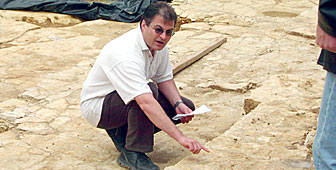Planned motorway was once a dinosaur thoroughfare

Some 150 million years after dinosaurs crossed a Jurassic beach, hundreds of their footprints have been found in the path of a planned motorway.
Palaeontologists have discovered nearly 500 well preserved footprints in a layer of limestone near the village of Courtedoux in canton Jura.
“The find is of exceptional scientific value,” said Christian Meyer, director of Basel’s natural history museum, who has studied dinosaur tracks for the past 15 years.
However, the site is threatened by the construction of the new TransJura highway, the A16.
Four-legged herbivores
Excavations at Courtedoux cover an area of about 800 square metres. The tracks belong to sauropods, a group of dinosaurs consisting of large, four-legged herbivores with very long necks and tails.
The biggest sauropods could reach 70 metres in length. However, the Courtedoux animals were fairly small – a mere ten metres on average from head to tail. The estimate is based on the 50-60 centimetre size of their footprints as well as the space betweeen them.
“This particular type of trackway has not been found before in Switzerland,” Meyer told swissinfo. “All the other sites where we find sauropods, the trackway width is fairly large and here it’s fairly narrow.”
The implication is that the tracks belong to either young dinosaurs or a specific group of sauropods.
Imagine the Bahamas
The site is also unique in Switzerland because of its flatness. Similar finds at Moutier in canton Bern and Lommiswil in canton Solothurn are on steep rock faces exposed by the folding of mountains.
At that time, this area was comparable to the Bahamas today, said geologist, Wolfgang Hug, head of canton Jura’s palaeontology section.
“We had beaches, islands, a dry climate, not too much humidity and elevated temperatures,” he told swissinfo.
Conifers, ferns and vegetation similar to palm trees made up the sauropods’ diet.
Juggernauts versus sauropods
Based on their measurements, the palaeontologists estimate that the sauropods ambled along at about three kilometres an hour.
Whatever their speed, the sauropods will be no match for the juggernauts of the new A16 unless its course is diverted or a bridge, which is planned about 100 metres south, is extended to cover and protect the tracks. The bridge is due to be built at the end of next year.
Discussions are currently underway with the relevant government departments as to how the zone can best be conserved.
Meanwhile, a team of 15 is working at the site. Months of analysis lie ahead to discover more about these animals whose passage was preserved for posterity in the sediment of a Jurassic beach.
by Vincent Landon

In compliance with the JTI standards
More: SWI swissinfo.ch certified by the Journalism Trust Initiative
You can find an overview of ongoing debates with our journalists here. Please join us!
If you want to start a conversation about a topic raised in this article or want to report factual errors, email us at english@swissinfo.ch.